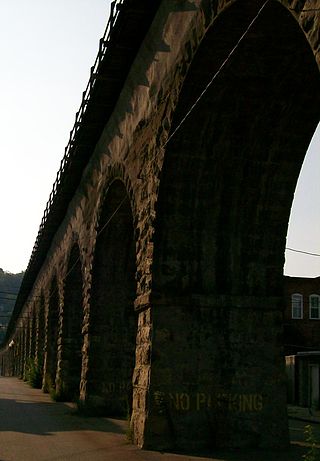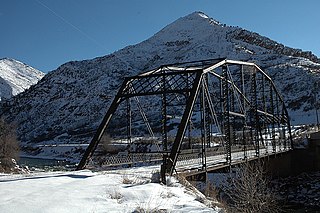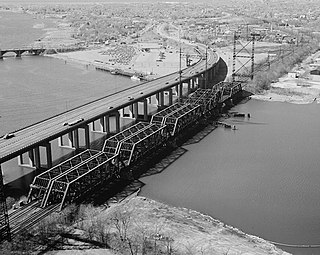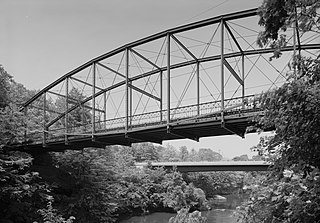
Knights Ferry is an unincorporated historic community in Stanislaus County, California, United States. Nestled in the foothills of the Sierra Nevada, it is about 30 miles (48 km) east of Modesto on the Stanislaus River. The Williams Ranch near the town was one of many filming locations for the television series Bonanza and Little House on the Prairie.

The Bollman Truss Railroad Bridge across the Little Patuxent River at Savage, Maryland, is one of the oldest standing iron railroad bridges in the United States and the sole surviving example of a revolutionary design in the history of American bridge engineering. The 160-foot (48.8 m) double-span was built in 1852 at an unknown location on the main line of the Baltimore and Ohio Railroad. It was moved 35 years later to its present location, where it replaced the very first Bollman bridge. Today, it carries the Savage Mill Trail.

The Phoenix Iron Works, located in Phoenixville, Pennsylvania, was a manufacturer of iron and related products during the 19th century and early 20th century. Phoenix Iron Company was a major producer of cannon for the Union Army during the American Civil War. The company also produced the Phoenix column, an advance in construction material. Company facilities are a core component of the Phoenixville Historic District, a National Register of Historic Places site that was in 2006 recognized as a historic landmark by ASM International.

B & O Railroad Viaduct is a historic structure in Bellaire, Ohio, listed in the National Register of Historic Places on June 22, 1976.

The South Canon Bridge is a truss footbridge spanning the Colorado River near Glenwood Springs, Colorado. It was built in 1915 by the Missouri Valley Bridge & Iron Co. It was listed on the National Register of Historic Places in 1985.).

Old Blenheim Bridge was a wooden covered bridge that spanned Schoharie Creek in North Blenheim, New York, United States. With an open span of 210 feet (64 m), it had the second longest span of any surviving single-span covered bridge in the world. The 1862 Bridgeport Covered Bridge in Nevada County, California, currently undergoing repairs due to 1986 flooding is longer overall at 233 feet (71 m) but is argued to have a 208 feet (63 m) clear span. The bridge, opened in 1855, was also one of the oldest of its type in the United States. It was destroyed by flooding resulting from Tropical Storm Irene in 2011. Rebuilding of the bridge commenced in 2017 and was completed in 2018.

The Bridgeport Covered Bridge is located in Bridgeport, Nevada County, California, southwest of French Corral and north of Lake Wildwood. It is used as a pedestrian crossing over the South Yuba River. The bridge was built in 1862 by David John Wood. Its lumber came from Plum Valley in Sierra County, California. The bridge was closed to vehicular traffic in 1972 and pedestrian traffic in 2011 due to deferred maintenance and "structural problems".

The Riverside Avenue Bridge is the only cast-iron bridge in Connecticut and one of a small number still in use in the United States. It carries Riverside Avenue over the New Haven Line railroad tracks in the Riverside section of Greenwich, Connecticut. The bridge was part of an earlier span built in 1871 over the Housatonic River by the New York and New Haven Railroad, and when that bridge was replaced, part of it was erected in Riverside in 1895. It was placed on the National Register of Historic Places in 1977.

The Bardwell's Ferry Bridge, built in 1882, is a historic lenticular truss bridge spanning the Deerfield River between the towns of Shelburne and Conway in Franklin County, Massachusetts. The bridge is listed on the National Register of Historic Places and is designated as a Massachusetts Historic Civil Engineering Landmark by the American Society of Civil Engineers.

The 19th Street Bridge is a two-span through Pratt truss road bridge in Denver, Colorado, over the South Platte River, now used for pedestrians. It was built in 1888 to replace a wooden structure and carried automobile traffic until 1986. The bridge is listed on the National Register of Historic Places.

The Housatonic River Railroad Bridge is a historic bridge carrying Metro-North Railroad's New Haven Line trackage across the lower Housatonic River in the U.S. state of Connecticut. The bridge is also used by Amtrak for its Northeast Corridor services. It was listed on the National Register of Historic Places in 1987, which also refers to the bridge as the Devon Bridge. It is also referred to as the Devon Railroad Bridge by the state Department of Environmental Protection.

The Lover's Leap Bridge is a wrought-iron lenticular truss bridge over the Housatonic River located in Lovers Leap State Park in New Milford, Connecticut. Built in 1895 by the Berlin Iron Bridge Company, it is one of the last bridges built by the company and is a particularly ornate example of its work. It was listed on the National Register of Historic Places in 1976 and is now open only for foot traffic.

The Turn-of-River Bridge, also known as Old North Stamford Road Bridge, is a single-span lenticular pony truss bridge built by the Berlin Iron Bridge Company in 1892. It was listed on the National Register of Historic Places in 1987. It formerly brought the Old Stamford Road across the Rippowam River, but is now open only to pedestrian traffic, as the road ends shortly before the bridge.

The Wawona Covered Bridge is a covered bridge spanning the South Fork Merced River near Wawona, California, in Yosemite National Park. The open bridge was built by Galen Clark, the steward of what was then called the Yosemite Grant, in 1868, without its cladding. The open bridge was a component of Clark's proposed new road from Wawona to the Yosemite Valley. Clark was unable to complete the road, which he sold to the Washburn Group of investors along with his stopover lodging in 1874. In mid-1875 the Washburn Group completed the road to Yosemite Valley. It is one of twelve remaining covered bridges in California.

The Upper Paris Bridge is an historic structure located near the town of Coggon in rural Linn County, Iowa, United States. The pin-connected Whipple through truss bridge was built in 1879 as a wagon bridge. It was designed by the Wrought Iron Bridge Company of Canton, Ohio. The bridge was listed on the National Register of Historic Places in 1998 as a part of the Highway Bridges of Iowa MPS.

Gholson Bridge is a historic metal Pratt truss bridge spanning the Meherrin River near Lawrenceville, Brunswick County, Virginia. It was built in 1884 by the Wrought Iron Bridge Company. It consists of two spans. One span is 84 feet (26 m) long and the second is 100 feet 4 inches (30.58 m). It sits on an ashlar sandstone substructure.

Linville Creek Bridge is a historic Thacher truss bridge located near Broadway, Rockingham County, Virginia. It was built by the Wrought Iron Bridge Company in 1898. It is a single span, measuring 135 feet 11 inches (41.43 m) long. This bridge was formerly identified as a hybrid Whipple, incorporating aspects of both the double-intersection Pratt and the double-intersection Warren. The structure in actuality is a Thacher truss, a hybrid configuration incorporating elements of the Pratt, Warren, Fink, and Bollman trusses that was first patented by Edwin Thacher in 1883. Its unusual configuration and the bewildering number of descriptions that have been applied to it merely reinforce its position as a bridge that is a rare survivor of an uncommon form.

The California Powder Works Bridge is a historic covered bridge in Santa Cruz, California. It is a Smith truss bridge, built across the San Lorenzo River in 1872 by the California Powder Works, an explosives manufacturer whose factory complex stood on the river banks. The bridge was designated a National Historic Landmark in 2015 as one of the best-preserved national examples of the Smith truss. It is owned and maintained by the Paradise Park Masonic Club, and is open to pedestrian and vehicular traffic, with a posted weight limit of 5 tons.

The New Hampton Pony Pratt Truss Bridge is a historic pony Pratt truss bridge on Shoddy Mill Road in New Hampton of Lebanon Township, Hunterdon County, New Jersey. It crosses the Musconetcong River between Lebanon Township, Hunterdon County and Washington Township, Warren County. It was designed by Francis C. Lowthorp and built in 1868 by William Cowin of Lambertville, New Jersey. The bridge was added to the National Register of Historic Places on July 26, 1977 for its significance in engineering, industry and transportation. It is one of the few early examples of iron Pratt truss bridges remaining in the United States. It was later documented by the Historic American Engineering Record in 1991. It was added as a contributing property to the New Hampton Historic District on April 6, 1998.

The Glen Gardner Pony Pratt Truss Bridge is a historic pony Pratt truss bridge on School Street crossing the Spruce Run in Glen Gardner of Hunterdon County, New Jersey. It was designed by Francis C. Lowthorp and built in 1870 by William Cowin of Lambertville, New Jersey. The bridge was added to the National Register of Historic Places on September 22, 1977 for its significance in engineering, industry and transportation. It is one of the few early examples of iron Pratt truss bridges remaining in the United States. It was later documented by the Historic American Engineering Record in 1991.























